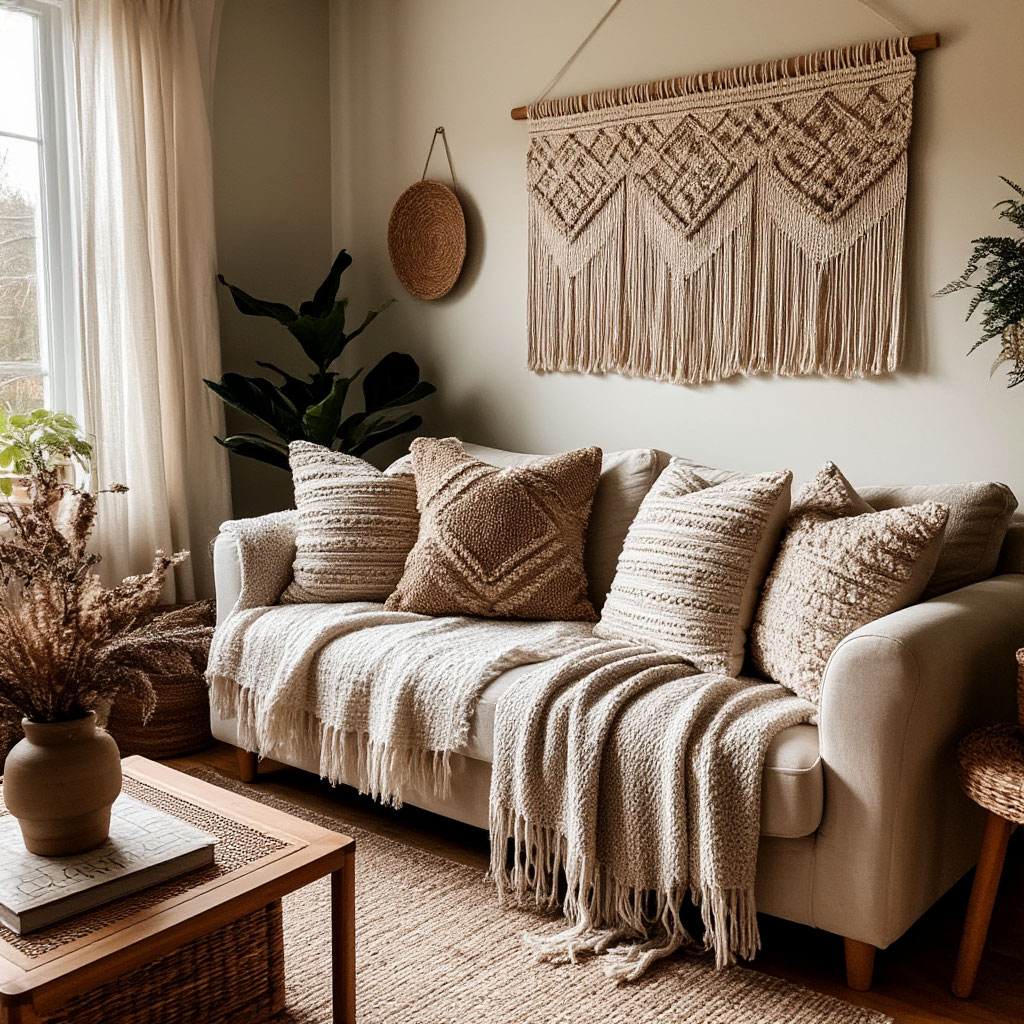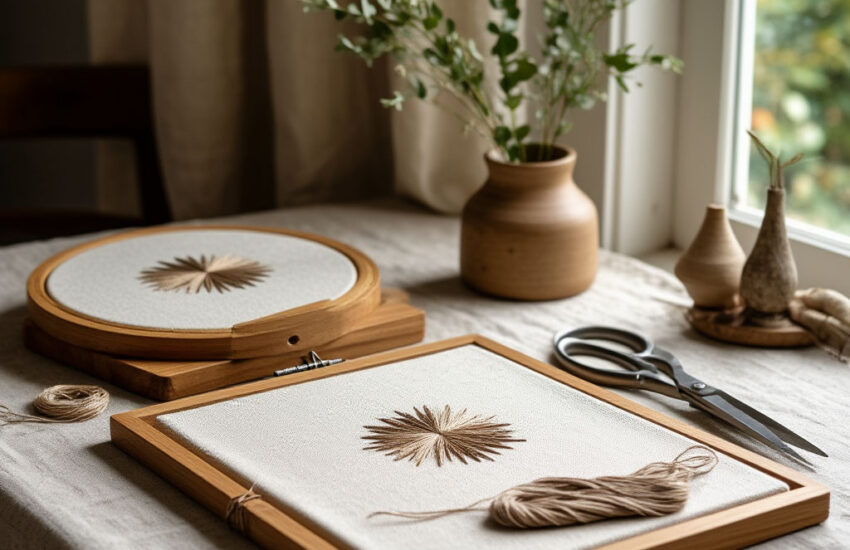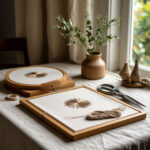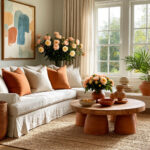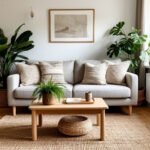Textile Decor That Instantly Warms Up Any Room
Contents
There’s something magical about textile decor—it’s like a warm hug for your home. Whether it’s fabric home accents softening a stark space or throw pillows adding a pop of personality, the right textiles can transform any room from cold to cozy in seconds.
And let’s not forget textile art USA lovers—those handwoven tapestries and fabric wall hangings bring soul to blank walls without a single nail. If you’re craving room warming ideas, start with cozy fabric accents that invite you to unwind. Think decorative pillows and throws casually draped over a sofa or layered at the foot of a bed—they’re the effortless upgrade every space needs. At the end of this article, you’ll be able to download a checklist that shows how to use textiles to create a cozy and welcoming atmosphere.
Why Textile Decor Creates Warmth and Comfort
Have you ever walked into a room and immediately felt at ease? Textile decor plays a big part in that. Our brains are wired to associate soft, tactile materials with safety and relaxation—think of the comfort of a favorite blanket or the inviting feeling of sinking into a plush sofa.
Unlike cold, hard surfaces, fabric accents in the home signal warmth, making a space feel lived-in and inviting. Research shows that rooms with layered textures reduce stress levels, which explains why we’re naturally drawn to cozy fabric accents. Whether it’s a chunky knit throw or a velvet pillow, these pieces don’t just look good—they make us feel good.
How Texture Tricks the Eye (and Heart)
Smooth leather and polished wood have their place, but nothing beats the instant warmth of woven, shag, or fluffy textures. Throw pillows in different fabrics – linen, faux fur or cable knit – add depth to a room, while American textile art styles like macrame or woven wall hangings add movement without overwhelming the space.
The magic is in the contrast: pairing sleek furniture with throw pillows and throws creates balance, preventing a room from feeling too sterile. Even one well-placed textile can soften sharp edges and make a space feel more intimate.
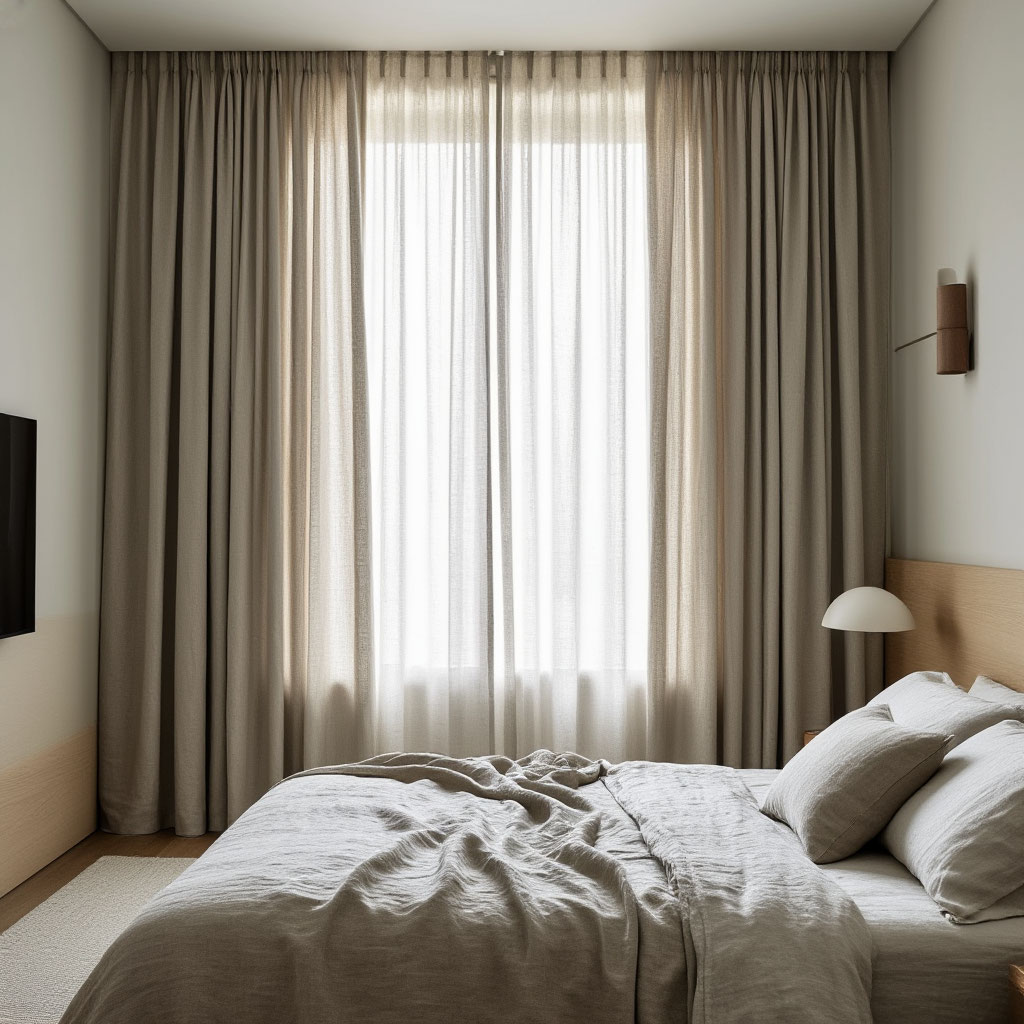
The Sound of Silence (Thanks to Fabric)
Hardwood floors and bare walls may look chic, but they also amplify every echo, making rooms feel empty. That’s where textile decor comes in as a hidden sound absorber. Heavy curtains muffle street noise, while rugs and upholstered furniture muffle footsteps and chatter. The result is a quieter, calmer environment that’s conducive to relaxation. Fabric accents in the home, like table runners or fabric lampshades, contribute to this effect, proving that small touches can have a big impact on the atmosphere.
Color and pattern: A mood-boosting duo
In addition to texture, the shades and patterns in your textiles play a huge role in setting the mood of a room:
- Earth tones and muted palettes (think warm terracotta, soft green, and creamy beige) evoke a sense of comfort.
- Bold patterns, like tribal prints or large florals, add energy without being overwhelming.
- Cozy fabric accents in rich colors can make large rooms feel cozy, while lighter shades keep smaller spaces airy.
And let’s not forget about seasonal swaps: swapping out summer bedding for winter wool is one of the easiest ideas for warming up a room when the temperature drops.
The Tactile Factor: Why We Crave Tactile Spaces
A room can be visually stunning, but if it doesn’t invite you to linger, what’s the point? That’s the power of textile decor—it begs to be touched. A faux fur throw draped over a chair isn’t just decorative. It’s an open invitation to curl up with a book.
Throw pillows and throws in different fabrics encourage interaction, making guests (and even you) more likely to relax rather than sit motionless on the edge of the couch. This tactile interaction is why hotels and upscale Airbnbs layer textiles so carefully—they know that comfort keeps people coming back.

The Nostalgia Effect: Textiles That Feel Like Home
Some fabrics just feel nostalgic—a well-worn blanket, a well-worn throw, or even a vintage textile piece in the US can evoke memories of grandma’s house or a favorite vacation spot. Unlike mass-produced decor, textiles often carry emotional weight, whether it’s the roughness of burlap that reminds you of a country getaway or the smoothness of silk that recalls a special occasion. By weaving these materials into your space, you’re not just decorating — you’re creating a sense of belonging.
Warmth That Can’t Be Fake
Trends come and go, but the desire for comfort never goes out of style. Textile decor isn’t about following rules — it’s about creating a space that feels authentically yours. Whether you lean toward minimalist neutrals or bold, pattern-heavy layers, pairing the right fabric accents for your home will ensure that your home doesn’t just look good — it feels like a sanctuary.
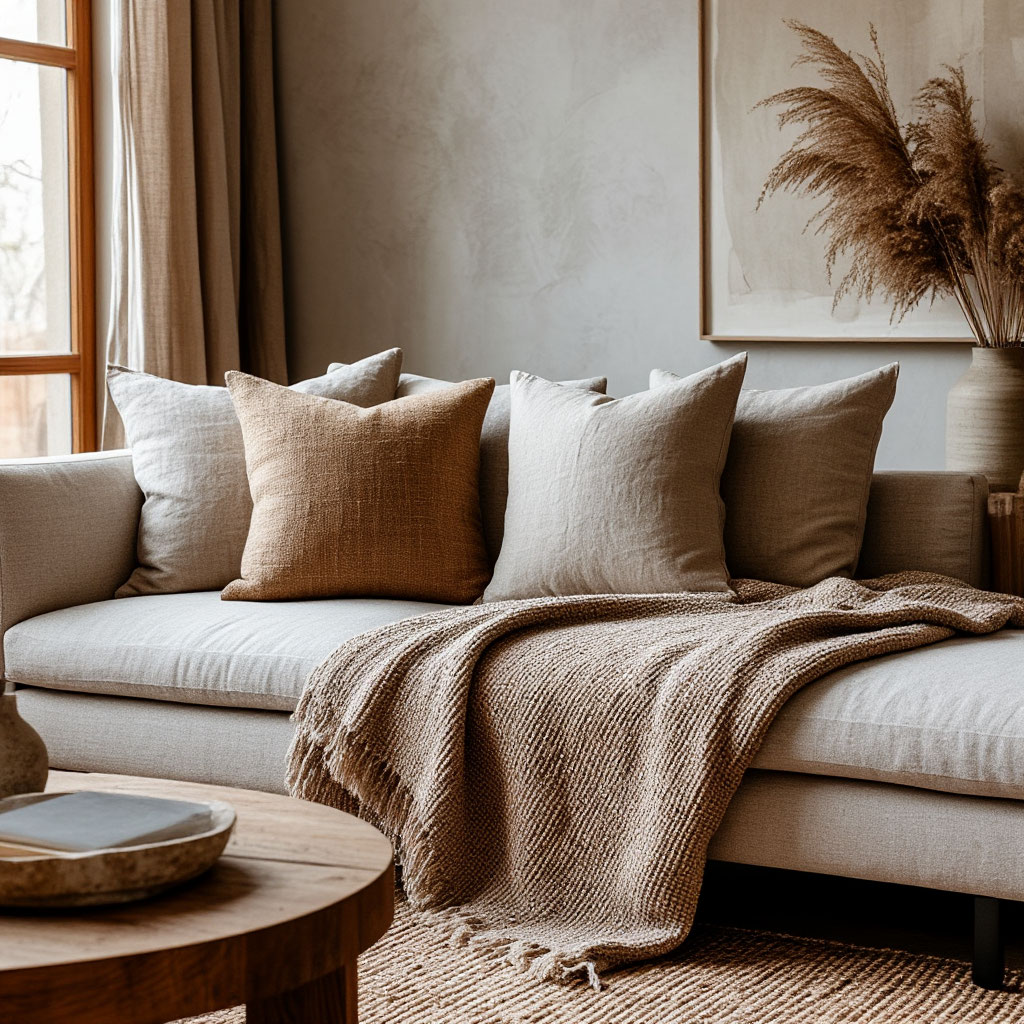
The Best Home Textiles to Try in 2025
Forget stiff, formal fabrics—next year, textile decor will be as pleasing to the touch as it is to the eye. Designers are leaning toward luxury, where fabric accents in the home combine high-quality textures with a relaxed vibe. Think:
- soft linens with a subtle sheen;
- recycled cotton that gets softer with every wash;
- throw pillows that look artfully rumpled rather than perfectly fluffed.
Spaces that invite you to kick off your shoes and stay a while.
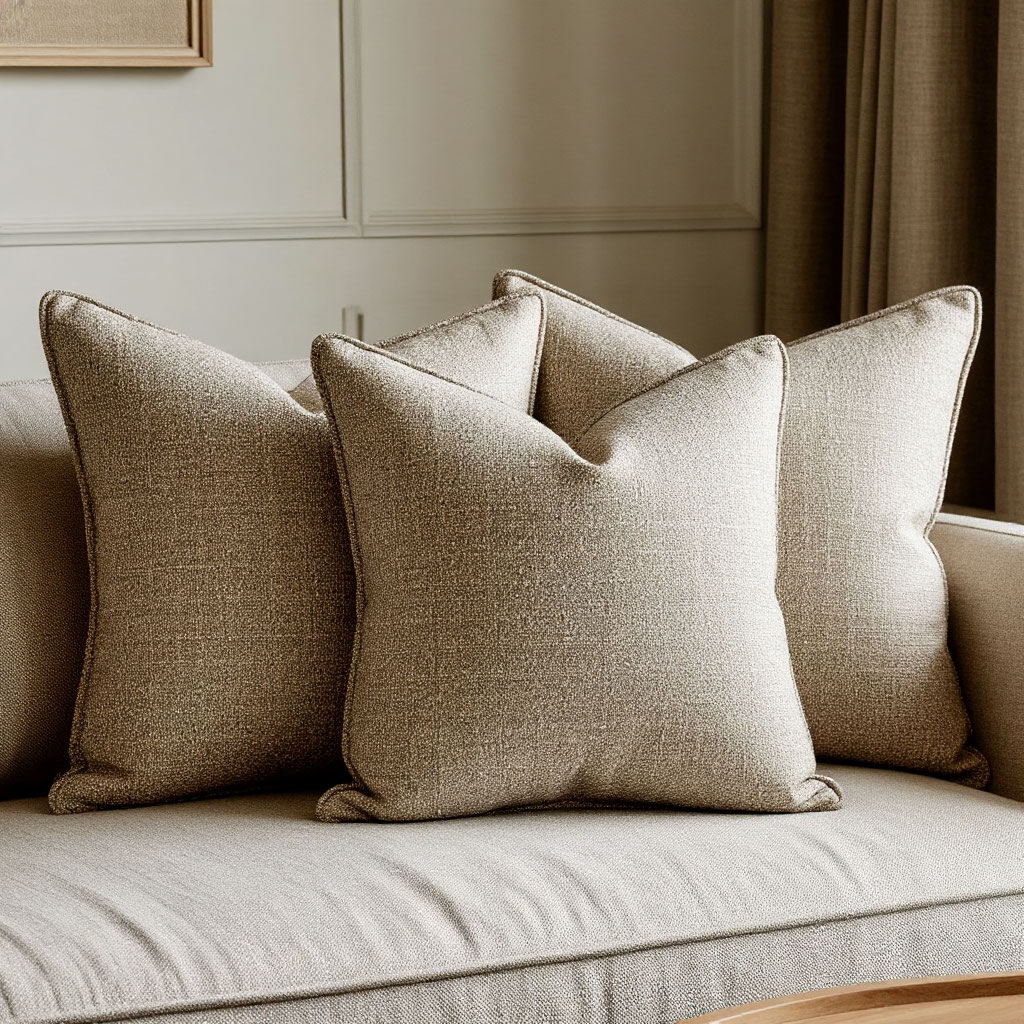
Pillows that do double duty
Throw pillows and throws are getting smarter in 2025. We’re seeing innovative fillings like buckwheat hulls (for cooling) and modular designs that let you swap out covers seasonally without cluttering your closet with inserts. But the real stars are the fabrics:
- overdyed velvets with intentional fading;
- jacquard weaves that tell a story (like the snuggly pieces from Textile Arts USA);
- fabrics that resist stains without feeling plasticky.
Pro tip: Layer a lumbar pillow in an earthy, faux-leather fabric over a plush square for instant volume.
Rule-Breaking Throws
Throws are shedding their afterthought status and becoming the center of attention. Think cozy fabric accents like heavy merino wool draped over contemporary sofas, or crushed silk-cotton blends in jewel tones folded at the foot of the bed. The unexpected twist? Asymmetry. Designers are hacking standard throws by cutting them into uneven shapes or adding bold, off-center fringe. For ideas on warming up a room with a little edge, try a raw-edged sheepskin throw draped over a minimalist chair—it’s like a leather jacket for your furniture.
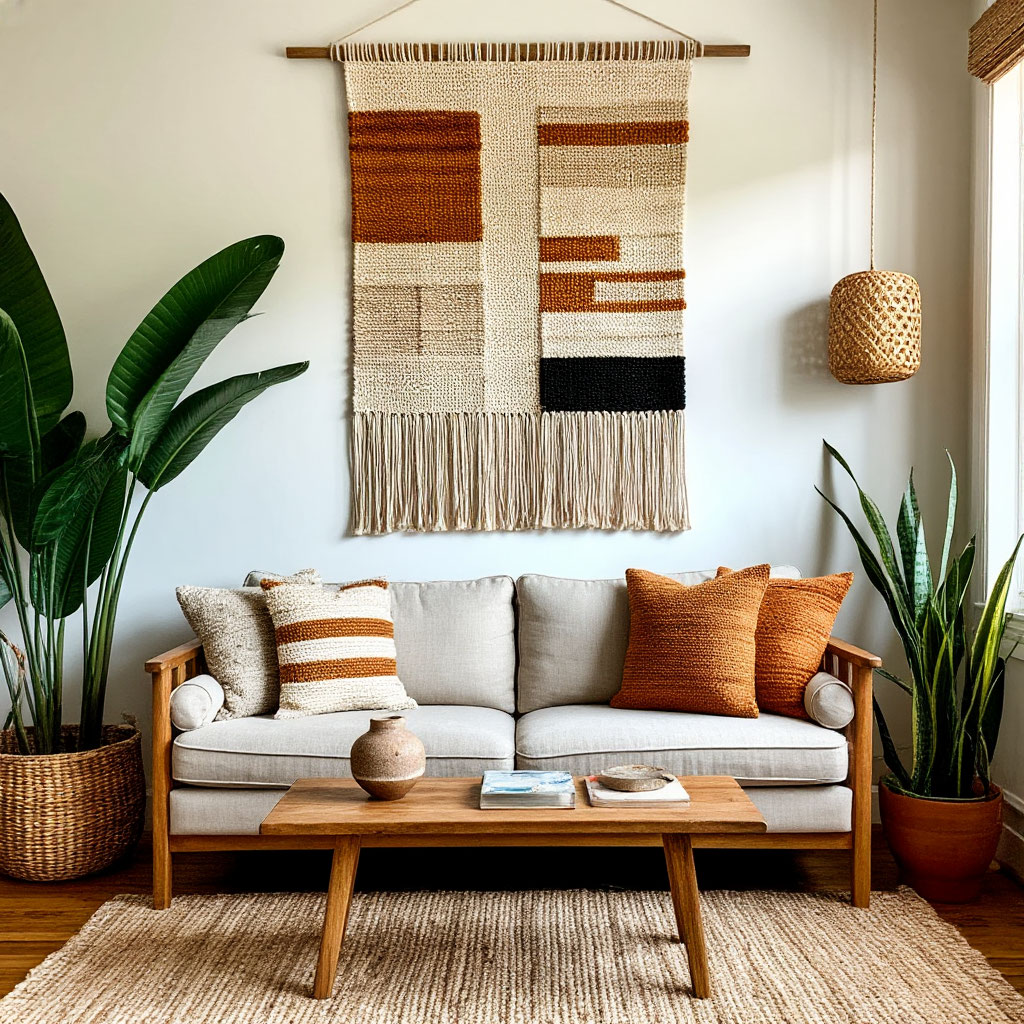
Fabric wall art that feels alive
Move over, framed prints—US textile art is being transformed into a 3D experience. Hand-woven rope installations, floating felt panels that cast shadow patterns as the light changes, and quilted wall hangings with hidden pockets (for notes or dried flowers) transform walls into tactile galleries. And the best part? These pieces absorb sound, making them a stealthy choice for open spaces that need a little acoustic softening.
Curtains that do more than just cover windows
Window treatments for 2025 are functional sculptures. Look for fabric accents for the home, like pleated linen curtains with magnetic edges (for easy opening/closing); and sheer wool blends that filter light like a vintage photo filter. In kitchens, cotton cafe curtains dyed with grasses bring organic color, while in bedrooms, thick, thermal-lined curtains get a luxurious feel thanks to hidden embroidery along the leading edges—a detail that’s only visible when the curtains are closed.
Rugs You’ll Want to Relax On
The days of rugs as afterthoughts are over. Next year’s flooring will be made to be a destination, with textile decor like ultra-plush alpaca piles so deep it feels like you’re walking on moss, or smooth fabrics with photorealistic botanical patterns (clover field hoax, anyone?). For ideas to warm up small spaces, try an exaggerated scale pelt rug—it tricks the eye into seeing more square footage.
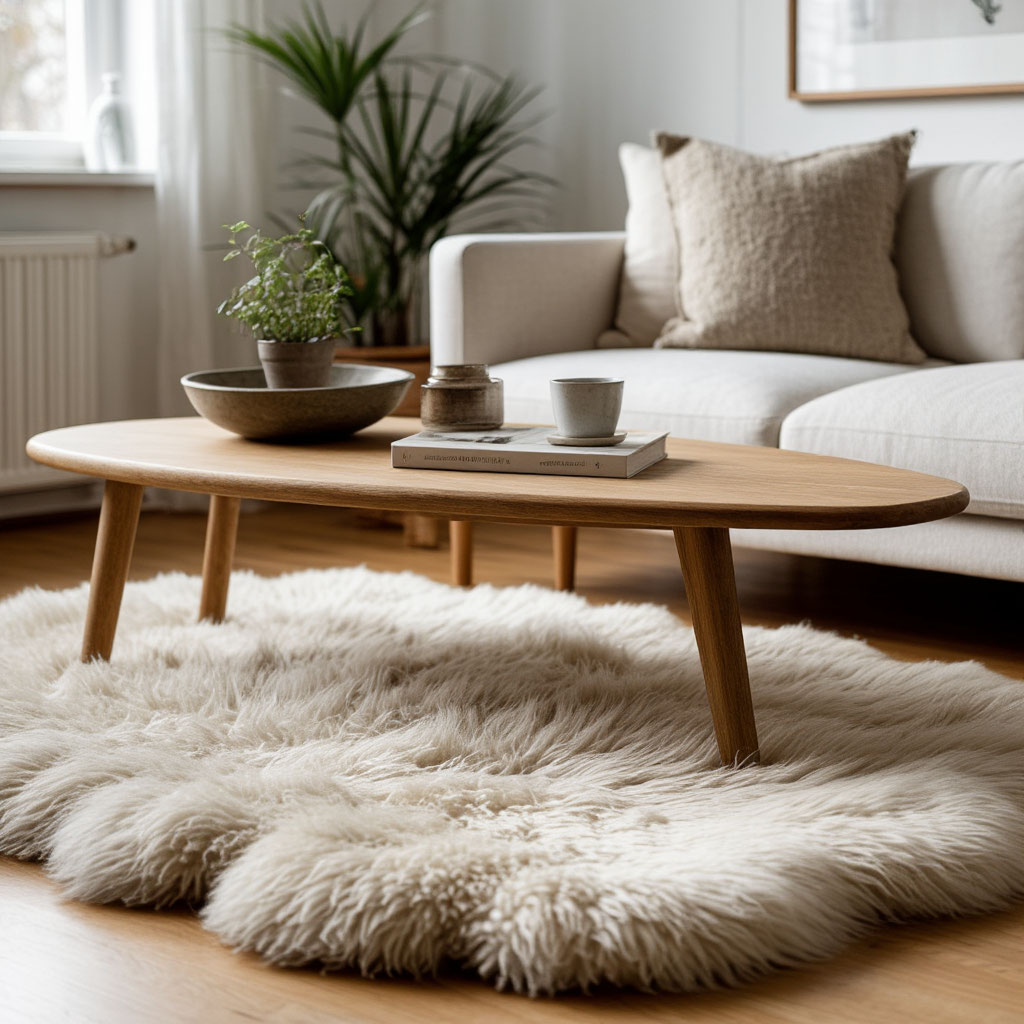
Table Linens That Spark Joy
Tablecloths and napkins are having a renaissance with cozy fabric accents like clumpy hemp blends dyed in seasonal hues (persimmon for fall, icy blue for winter). The trend? “Imperfect” sets, in which each piece is a slightly different shade, paying homage to the natural variations in dye. For drama, layer a crisp white tablecloth under a sheer embroidered overlay—it’s an instant heirloom feel without the heirloom price tag.
Bedding That Feels Like Intimacy
Hotels have long understood that great bedding means instant relaxation. 2025 goes further with throw pillows and throws built into duvet cover designs (think: attached pillowcases with hidden zippers for easy washing) and fitted sheets with non-slip grips along the elastic. Fabrics to look for: lightweight wool for temperature regulation and triple-gauze cotton that gets buttery soft with every wash.
The through line for 2025? Intentional eclecticism. Instead of perfectly coordinated sets, the magic happens when you pair a vintage textile art USA wall hanging with a hyper-modern rug, or team a sleek leather sofa with a chunky, hand-knit throw. It’s about creating spaces that feel collected over time—because the coziest homes always tell a story.
Where to Place Throws, Pillows, and Fabric Art
Proper placement of textile decor can mean the difference between a chaotic look and designer brilliance. Those fabric accents for the home you’ve invested in deserve thoughtful placement to truly transform your space. These could be:
- throw pillows that add personality to your sofa;
- textile art pieces from the USA that create focal points.
Every placement decision should serve both form and function.
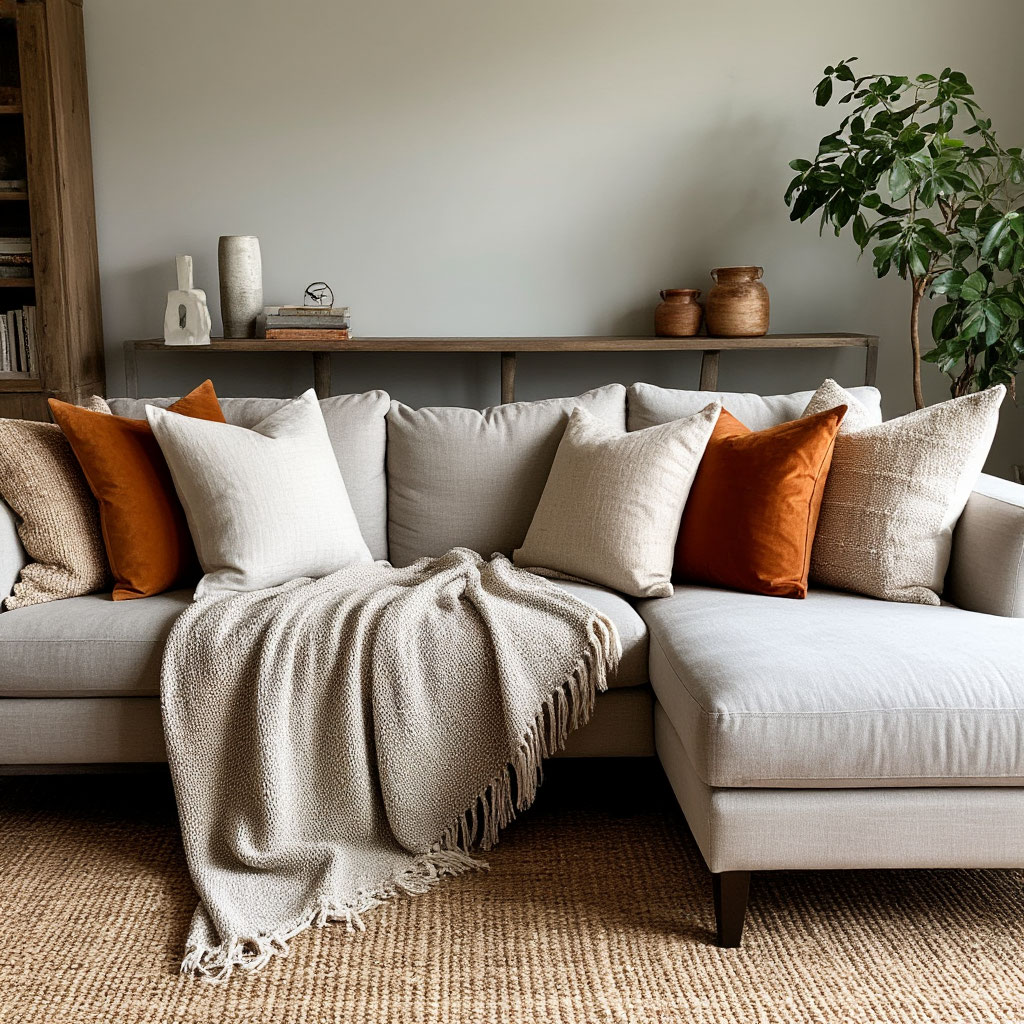
A Sofa Style That Actually Works
Your living room offers prime space for throw pillows and throws, but there’s a method to the madness of placement:
- Start with large back pillows in neutral tones.
- Pile smaller accent pieces in bolder patterns or textures.
- Drop a cozy fabric accent throw casually over one arm rather than perfectly centered for a coveted elegance.
For sectionals, try grouping pillows in odd numbers on each section to maintain visual balance without looking too monotonous.
Bedding Arrangements That Will Enhance Your Sleeping Space
The bedroom may be the most important place to strategically place textile decor. Start with pillows at the head of the bed, then add European pillowcases to the front for height. A pair of throw pillows in the front will add sparkle, while a folded throw at the foot of the bed will provide both style and easy access for chilly nights. For ideas on how to warm up a room with added dimension, try layering a lightweight blanket under the duvet and stacking both to reveal beautiful textile combinations underneath.
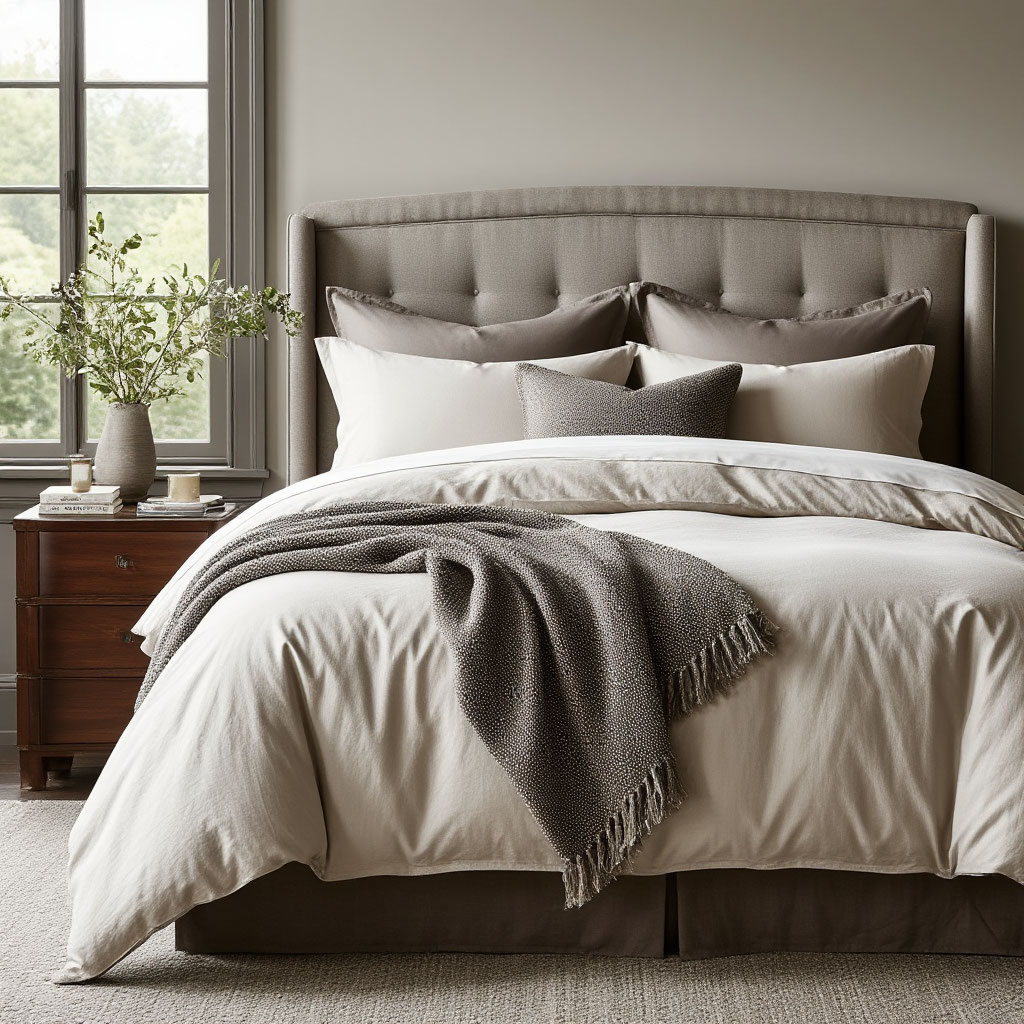
Wall Decor That Tells a Story
Textile art from the United States deserves careful consideration when placing. Large woven pieces work wonders over beds or sofas, instantly creating a focal point. Small fabric pieces shine when grouped in gallery displays with other textural elements, like wood or metal frames.
Be sure to hang items at eye level (approximately 57-60 inches from the floor to the center) unless you’re creating a dramatic floor-to-ceiling installation. For maximum impact, place fabric wall hangings where natural light can enhance their texture throughout the day.
Unexpected Places for Fabric Accents
Don’t limit fabric accents in your home to traditional spots. Drape a lightweight throw over a wooden bathroom staircase for spa-like luxury. Layer a collection of throw pillows on window seats or built-in bookshelves to create cozy reading nooks. Even dining chairs benefit from small fabric pillows, which make long dinners more comfortable. For cozy fabric accents with functionality, try hanging a fabric pocket organizer on the back of a door to collect small items and add softness to the space.
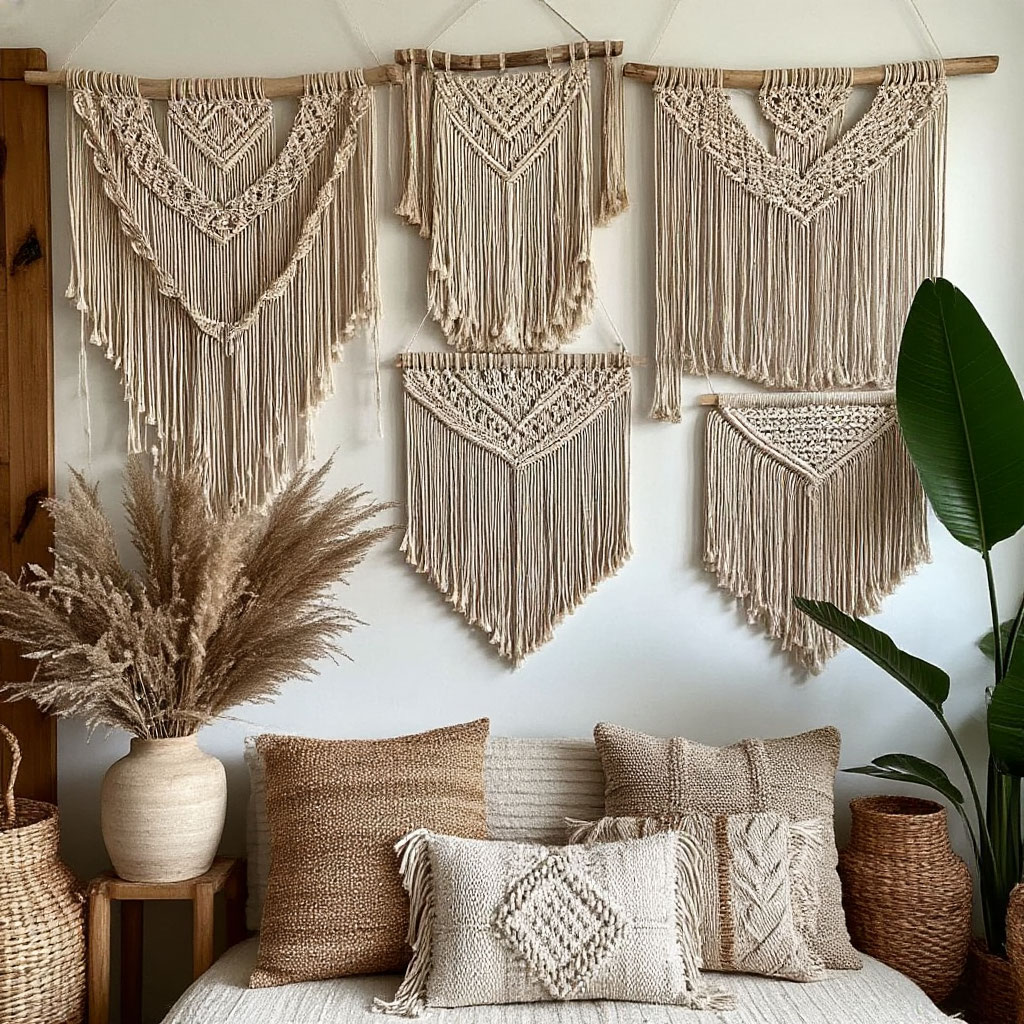
Layering Techniques for Depth and Dimension
The magic happens when you start combining different textile decor elements:
- Lay a textured rug under a sofa group.
- Drop a small piece of pelt or patterned material on top.
- Hang sheer curtains with heavier curtains behind them for adjustable light control and visual interest.
When arranging throw pillows and throws, mix sizes and fabrics, but maintain some color continuity to keep the look cohesive. Remember that odd groupings (three or five pieces) usually create the most pleasing arrangements.
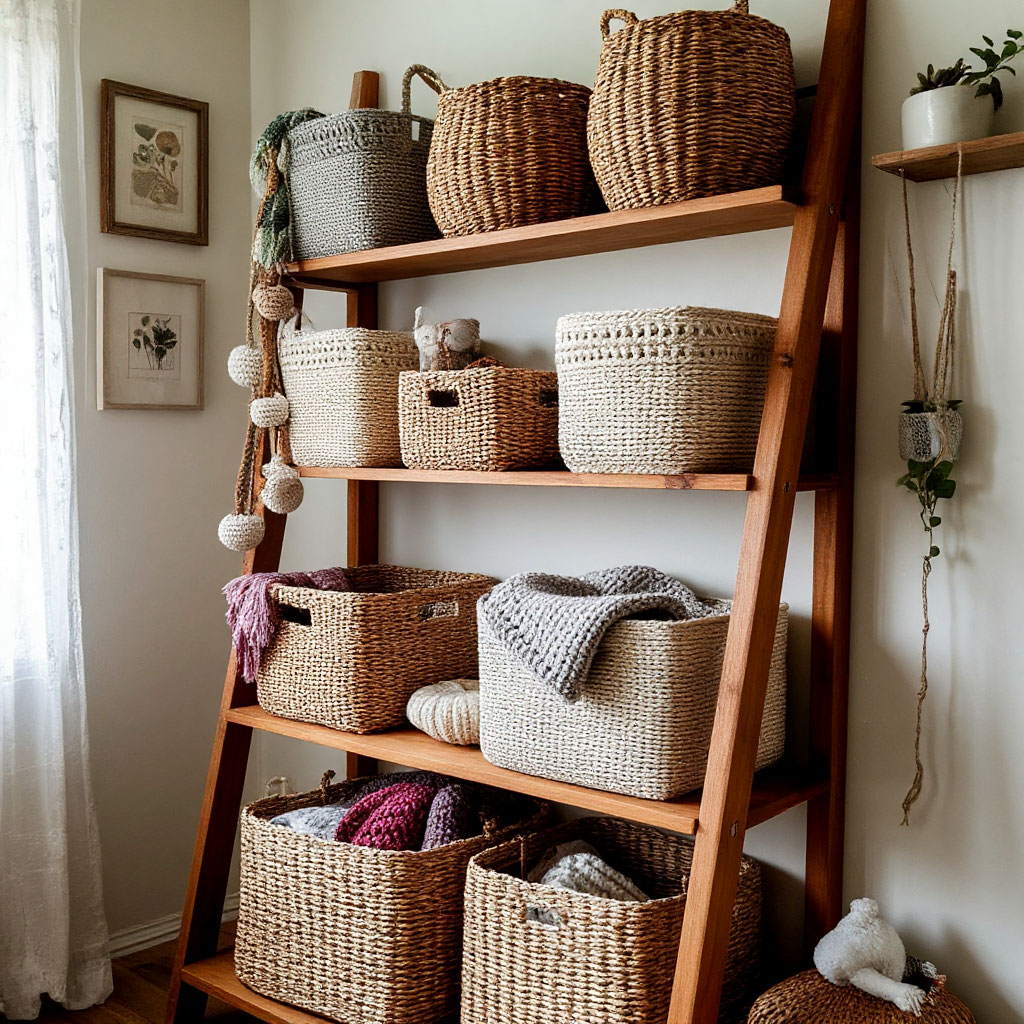
Functional Placement for Everyday Living
While aesthetics are important, your textile art pieces and fabric accessories should fit your lifestyle. Keep throws within easy reach of favorite seating areas. Place floor pillows near coffee tables where guests naturally congregate. Hang fabric wall art in areas where you want to absorb sound, like home offices or open-plan living rooms. For room-warming ideas that serve two purposes, use a pretty folded blanket as a bed runner during the day that turns into real warmth at night.
Editing Your Fabric Arrangement
Sometimes less really is more with fabric accents at home. Step back and assess your space — if one area feels cluttered, try removing one piece of fabric decor and see if the arrangement improves. Rotate seasonal pieces rather than displaying everything at once to keep your decor fresh. And remember, the best arrangement changes over time as you discover what placement really enhances both the beauty of your space and your everyday comfort.
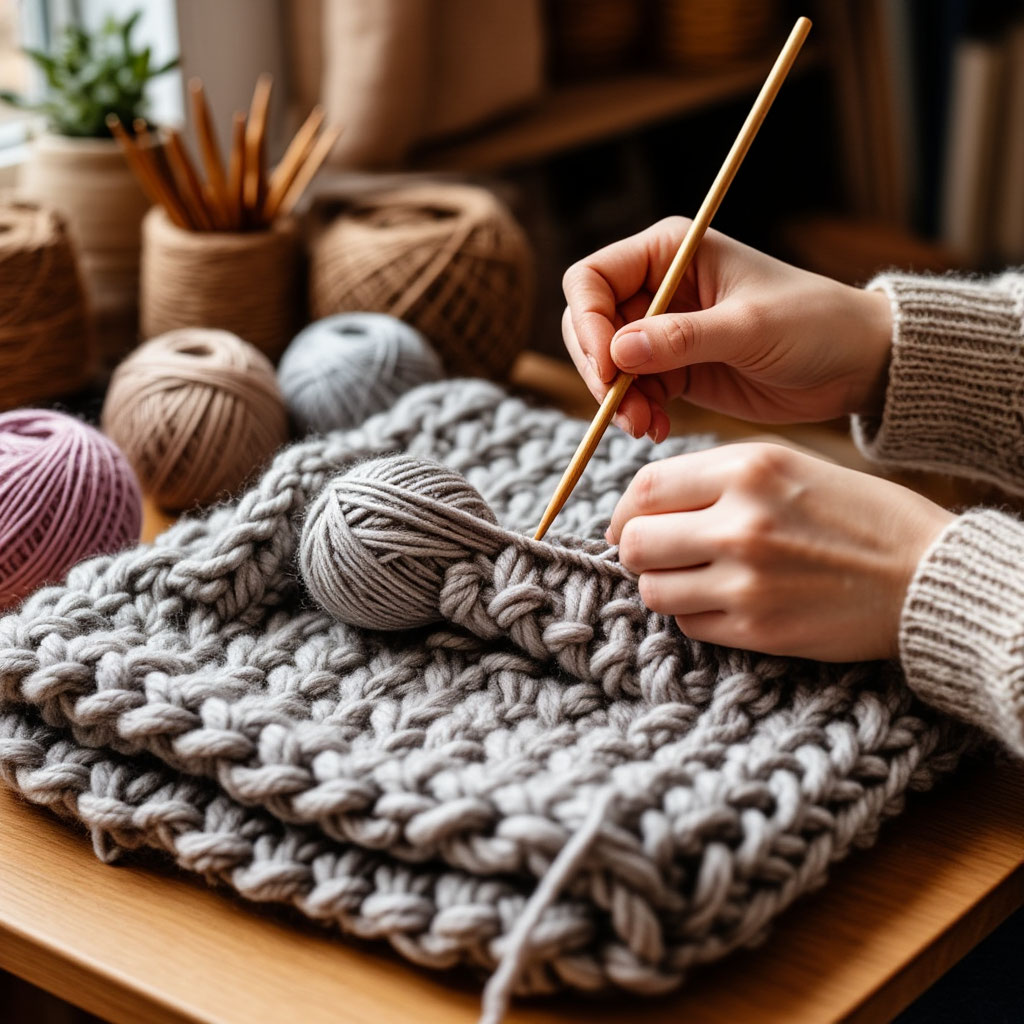
Stitch & Craft Picks for Cozy Rooms
There’s something special about filling your home with textile decor that you’ve made yourself. Unlike store-bought items, DIY fabric home accents have that personal touch—imperfections and all. Whether you’re knitting a chunky throw blanket, stitching pillows, or making American Textile Art-inspired wall hangings, handmade pieces bring soul to a space. And the best part? You don’t have to be an expert to create cozy fabric accents that look expensive.
Beginner Projects to Try Tonight
If you’re new to crafting, start simple. A seamless blanket with plush fleece fringe takes less than an hour to make, but looks like a high-quality throw pillow and throw. For something more tactile, try macrame plant hangers using thick cotton rope—they add a boho charm while still keeping greenery in the mix. Another easy win? Fabric-wrapped canvases. Stretch printed or dyed fabric over a frame, pin the edges, and boom—an instant American textile art experience without having to pick up a needle.
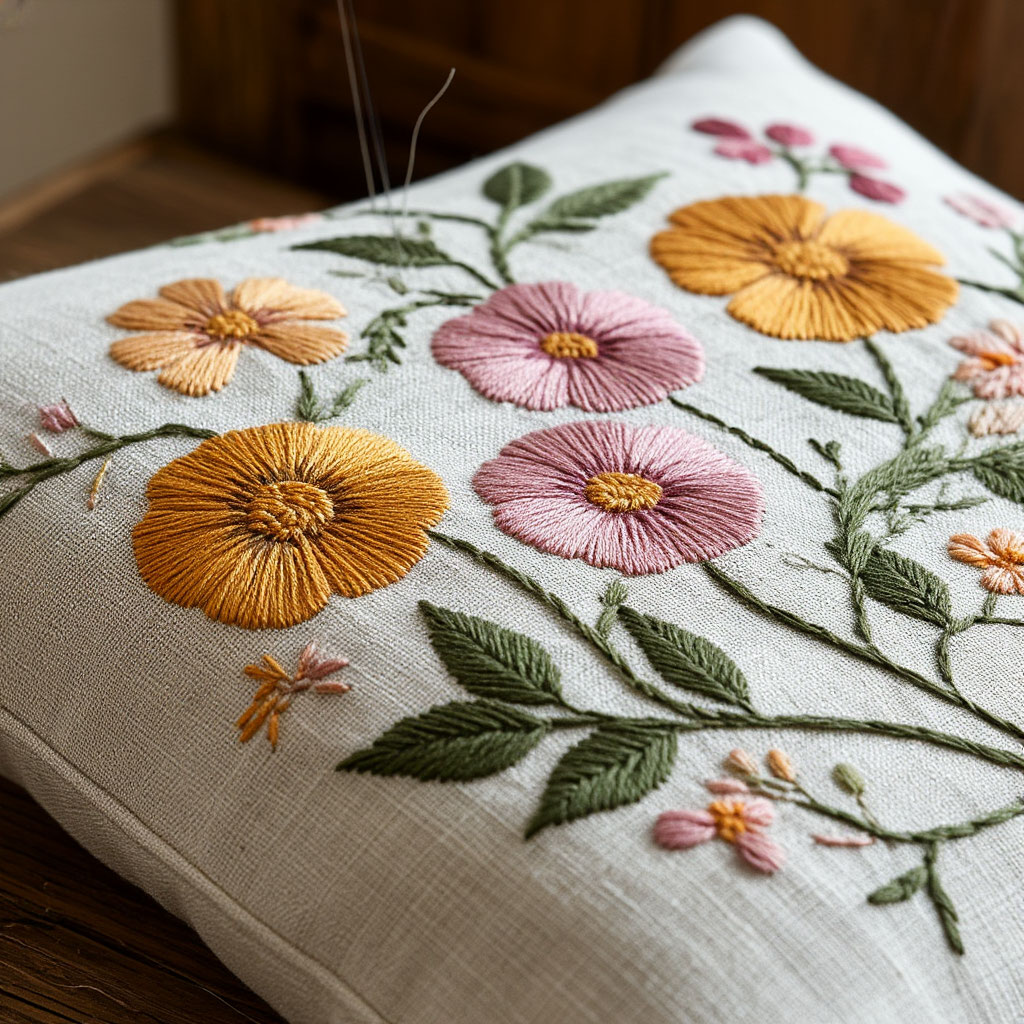
Yarn Choices That Matter
Not all fibers are created equal. For room-warming ideas that will last, ditch the cheap acrylic and opt for natural materials like merino wool (soft but durable) or bamboo-blend yarns (silky and breathable). If allergies are a concern, hypoallergenic cotton or linen are great for creating cozy fabric accents. Pro tip: Multicolored yarns with subtle color shifts create visual interest without requiring advanced skills, making them ideal for beginning knitters and crocheters.
Embroidery That Elevates the Everyday
Make ordinary linen special with strategic stitches. Update simple pillowcases with minimalist floral embroidery, or add a monogram to tea towels for a personal touch. For textile decor with an artistic twist, try thread painting—using long and short stitches to “paint” landscapes or abstract patterns onto fabric. Frame the finished piece in a floating frame for an Americana textile art look. Even simple running stitches in contrasting thread can transform a store-bought throw into something uniquely yours.
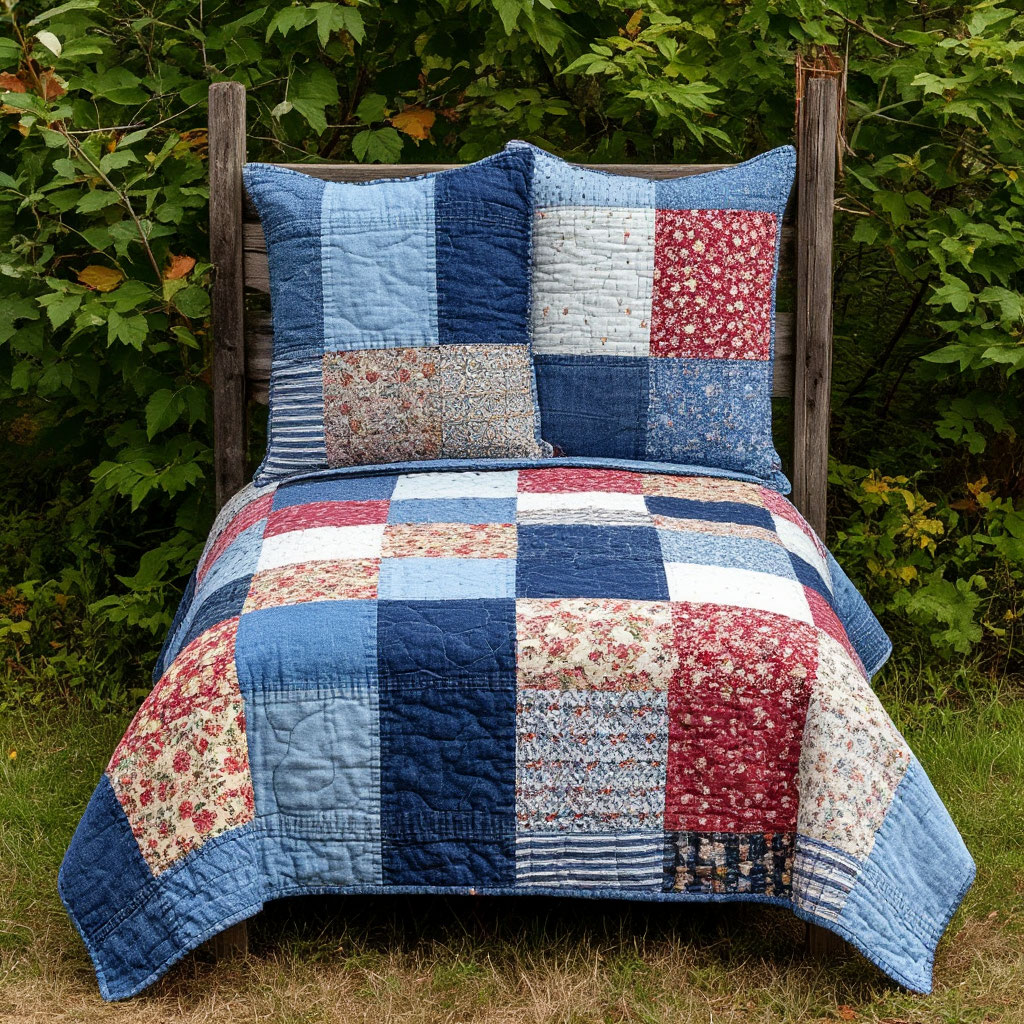
Upcycling for Unique Pieces
An old denim jacket? Make a throw pillow set. Vintage scarves? Perfect for a quilted wall hanging. Upcycling is not only eco-friendly, it instantly adds history and character to your fabric accents at home. Try cutting up floral sheets into envelope-style pillowcases, or repurposing wool sweaters (that have been felted in the wash) into a quilt. Imperfections add charm, and you’ll love telling guests, “Yes, I made that.”
Seasonal Swaps to Keep Things Fresh
Handmade throw pillows and throws allow you to switch up your looks without breaking the bank. Swap lightweight linen pillowcases for chunky knits when winter rolls around. Create a fall-themed wall hanging in burnt orange and mustard yarn, then swap it out for a pastel woven piece in the spring. These little changes will make your room-warming ideas feel new again, and since you’re making them yourself, you can match your home’s color story exactly.
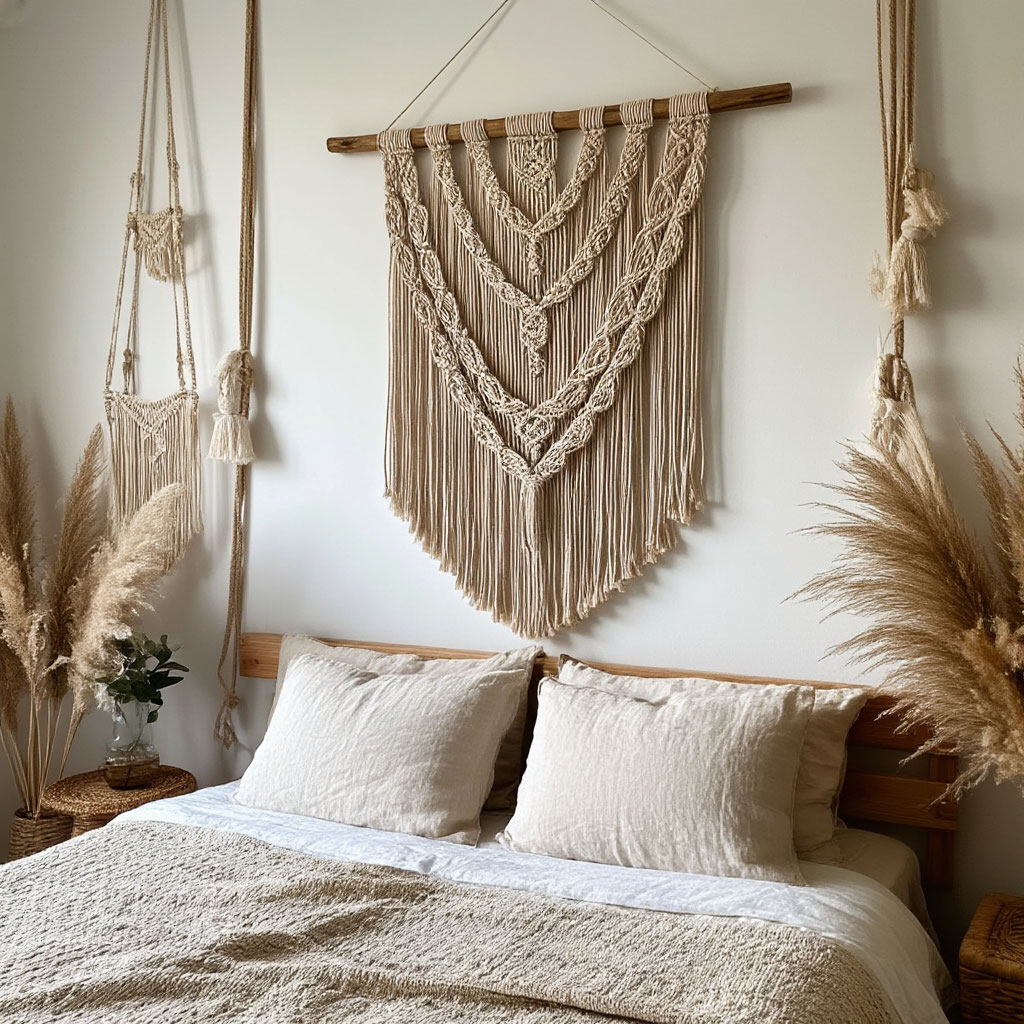
The Social Side of Sewing
Crafting doesn’t have to be solitary. Join a local knitting group or take a virtual workshop to learn new techniques while connecting with other artisans. Many textile arts communities across the U.S. host “stitch and knot” nights where you can work on projects and swap tips. Not only will this improve your skills, but it might just inspire you to create your own favorite cozy fabric accents in someone else’s work.
When to Invest in Quality Tools
A good set of knitting needles or an ergonomic crochet hook can make all the difference in your textile decor projects. If you’re serious about sewing, invest in sharp fabric scissors (use them only on textiles to keep them looking their best) and a sturdy sewing machine if you’re planning on working on larger projects like curtains or quilts. For hand-dyed fabrics, natural dyes like avocado pits or turmeric create gorgeous, subtle hues without harsh chemicals.
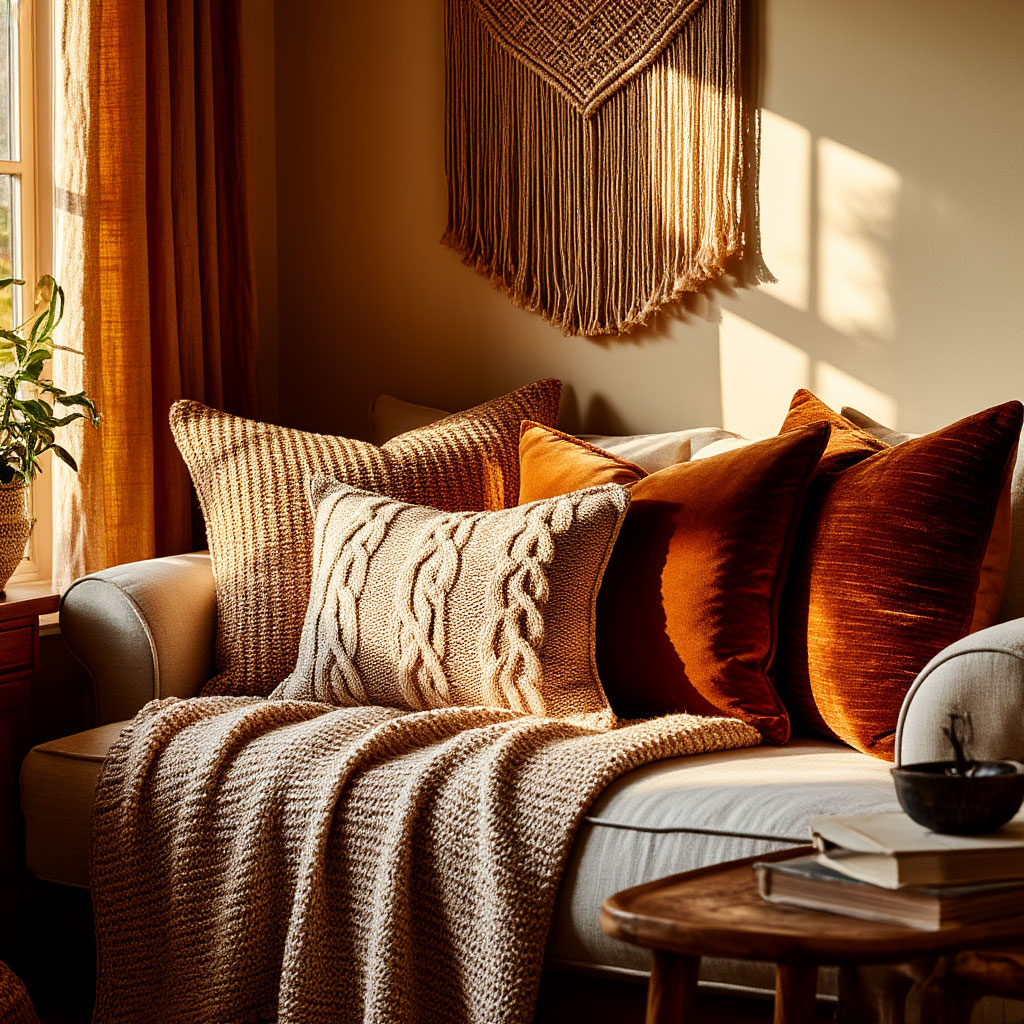
Why Handmade Textiles Feel Warmer
Mass-produced items lack the quirks that make DIY textile decor so inviting. A slightly uneven stitch, the subtle variations in hand-dyed fabric—these “flaws” add warmth that perfection can’t replicate. Every time you curl up under that blanket you knitted or admire the decorative pillows and throws you sewed, you’re not just seeing decor. You’re remembering the time and care that went into making your home truly yours.
Great textile decor isn’t just about aesthetics—it’s about creating spaces that feel as good as they look. Whether you’re layering throw pillows for a cozy nook, hanging textile art USA for a personal touch, or crafting your own fabric home accents, these elements add warmth you can’t fake.
From room warming ideas like draped blankets to decorative pillows and throws in rich textures, every piece tells a story. So go ahead—mix textures, play with color, and let your home reflect what makes you feel most at ease. After all, the coziest rooms aren’t designed—they’re lived in.
You can now download a textile decor checklist — a practical guide to layering fabrics, colors, and textures for instant warmth in any room.
